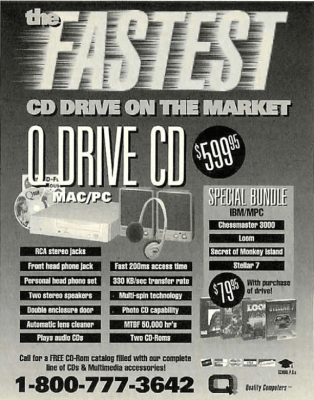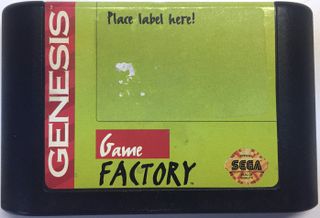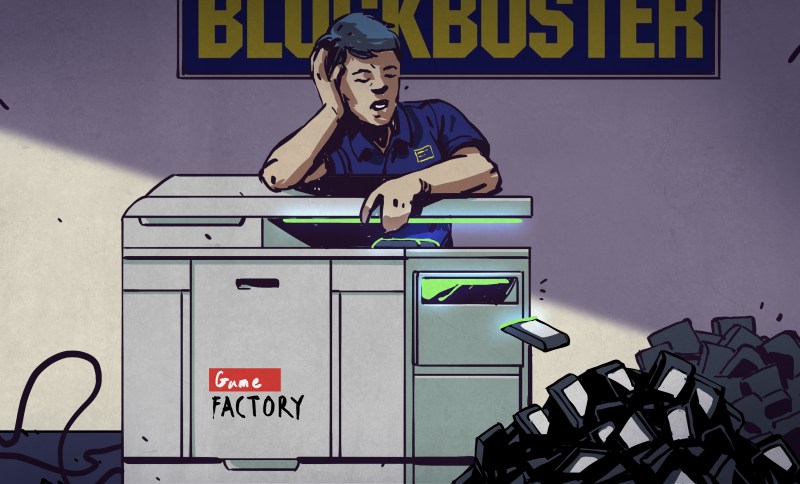By the onset of the 1990s one thing was clear, the future was digital. Analog format sales for music were down, CD sales were up; and it was evident, at least in the US, that people were bringing more computing devices into their homes. At the beginning of the decade, roughly 1 in 3 American households had a Nintendo Entertainment System in them, according to this Good Morning America segment.
With all those consoles out there, every shopping season became a contest of “who could wait in line the longest” to pickup the newest titles. This left last minute shoppers resorting to taking a rain check or return home empty handed. Things didn’t have to be this way. The digital world had emerged and physical media just needed to catch up. It would take an unlikely alliance of two disparate companies for others to open their minds.
Digital, On-Demand in the Early 1990s
Enter NewLeaf Entertainment. A joint venture between IBM and Blockbuster that originally set out to revamp the way people purchased their music and home video by creating physical media on-site and on demand.
“An information network that delivers virtually any type of entertainment product digitally, on demand to retail outlets just about anywhere on the planet.”
By supplying retailers with all blank CDs, VHS tapes, and jewel cases they could handle, every new release would be in stock and no older titles would ever go out of print. Paired with an interactive customer demo station, complete with 30-second song clips and a touchscreen, anyone could preview a title without the need for eye-assaulting end cap displays or retail employee intervention. All that was required would be for a customer to place an order and a little patience.

The idea was certainly sound. Consumers were already conditioned to the idea of one hour photo development services that were available at many department stores, so applying that model to CD and movie sales wouldn’t be that big of a stretch. Customers would walk to the electronics section, place an order, do the rest of their shopping, then pickup their album/movie of choice before heading to checkout.
The technology needed to make their own bootleg copy simply out of reach for your average consumer. P2P files sharing was almost non-existent, Internet connections were still measured in baud. Even if someone were able to obtain an unauthorized copy, a decent CD-ROM drive, sans burning capabilities, still cost in the neighborhood of $600.
State of the Art in Duplication
According to a former NewLeaf employee, “We built an extravagant demo center…that included high speed VHS duplication, bleeding edge 4X CD-Rom burners, first generation digital color printers, and robotics to automate the fabrication and assembly of a complete piece of media with all its packaging.” The typical album could be burned in the matter of a few minutes while the duplication time of movies were more variable due to the limitations of transferring to VHS tapes. The demo center’s content management system was connected by optic fiber telephone lines tied back to a mainframe in order to keep track of sales, and new releases could be downloaded from the same network connection.
In theory, everything on the technology side seemed to lineup; the issue would be in getting copyright holders to agree to this new distribution method. The fact that NewLeaf’s business model would essentially level the playing field for retailers regardless of size was an immediate non-starter for “The Big Six” record companies at the time.
One Cartridge, So Many Possibilities

Without the support of the major record labels or movie studios, it was time to pivot from the retail space. Blockbuster Video’s bread-and-butter was the rental business, and an emergent part of that business were video game rentals. Release dates in the video game industry were becoming more regimented; and with event-based release dates like Mortal Kombat’s “Mortal Monday”, Blockbuster would routinely run short on copies during the first week of a release. The concept of on-demand inventory generation made perfect sense for the rental business model. Additionally this was during the 16-bit era of console, the original console wars, where console manufacturers sought any and all opportunities to differentiate themselves from the competition. NewLeaf would find an ally in Sega of America who was all too eager to extend their support.
This pivot, dubbed Game Factory, was soon a reality as a collection of ten Blockbuster Video stores around the Columbia, SC area were chosen to be a test market. Machines at these stores had the ability to flash 16 Mb and 32 Mb EEPROM cartridges containing Sega Genesis games. The flashing process only took 45 seconds on average, and the bulk of Genesis games were able to fit on the two available memory capacities; though games like Virtua Racing that contained additional processors on the cartridge PCB would never be compatible.
A Victim of the Pace of Game Console Evolution
The Game Factory tests proved positive, however, it was 1994 and the revolutionary Sony PlayStation was out in Japan. The ever-evolving and proprietary nature of videogames would simply prove too much of a time sink, and in the midst of the Blockbuster-Viacom merger later that same year the entire project would be cancelled.
NewLeaf Entertainment took a bold approach to redefine the music shopping experience years before iTunes and the videogame buying experience years before Steam, but ultimately failed to convince content holders to adapt to a more consumer-centric distribution model. The one hour photo of physical media was simply too radical an idea for its day, though NewLeaf Entertainment’s story is probably best told by their pitchman…Dennis Miller.
















I have a few of the green label Game Factory carts (one has Toejam and Earl on it) and one blue label that I think is 32MB. Blank of course as they weren’t used when the program got abandoned before it launched.
That’s really cool, and you should post pictures of the carts somewhere on the internet. It couldn’t hurt to have a few more of them out there.
Plus if you can figure out how the flasher did its thing you can use them as flashcarts!
Interesting, although I wouldn’t swear to it, but I think some music stores had something similar.
There were a few companies vying to be the sole source provider at the time, but only NewLeaf Entertainment’s pitch video was hosted by Dennis Miller…90s Dennis Miller.
Many moons ago. The MediaPlay store near me had a CD on demand kiosk for a while. The couple of times it wasn’t “out of order” I found the content catalog to be pretty limited or only partially accessible.
No one could ever tell me if the content was actual CD bit rate file or something else.
#CD based “mix tapes”?
For honest, never been reconstituted/re-converted content, I would been much happier to pay a couple of bucks, per song, rather then getting stuck with $16 discs with one or two decent songs and a lot of contractually obligated filler.
The “out of order” unit eventually disappeared during one of the routine sales floor reshufflings.
Yes there was. It was pre-93 for me in Los Angeles area (moved out of town mid 92). The Warehouse music/video store had a cassette recording system that you look through a few books and write down by code, what songs you wanted on your tape. The songs (IIRC) cost 79 cents to $1.49 each song, and I think it was a 5 song minimum. They had a variety of lengths of cassettes they used.
The attendant would enter the song codes into the computer, it would tell them which tape to use, they insert the tame, then the recording begins, half way through, the tape would partially eject, flip around, and record the other side, it would finish up and the attendant would put printed track listing on both sides and a slip cover for the case.
The system used like a 100 disc changer, and the disc songs were recorded like at 5X normal speed and the cassette recorded at the same speed so there was supposed to be no difference in the quality.
I had a couple mixes made. I found one of my tapes and went to play it and the tape was broken. Need to fix and re listen to “the good ol’ days”.
Thanks for the inspiration for a new project :-)
Nintendo did pretty much the same thing as recently as 2003 with the iQue Player, a modified N64 for the Chinese market. It used a flash cartridge you downloaded games onto, first at stores, but later also online.
And as early as 1986. The Famicom disk system wrote games to disks that would then run on the Famicom.
SNES had the Satellaview too
Totally forgot about the iQue Player. I remember it was also pretty notable that it was effectively an N64 system-on-a-chip, which was pretty wild for the time.
I remember the “Sega Channel”, when we moved to Oregon in 1995 the local cable company offered it, and Dad agreed we could get it, but wanted to wait a few months. When he called to add it, it was basically the month they were ending it, and said by the time the equipment arrived It would work for like 2-3 days before they shut the service down so it wasn’t worth it :-(
Smart dad.
The irony is on the bix six for not assimilating the CD-burning business.
The pigments on a CD-R are chemically unstable, and a great deal of them fail within 2-3 years. No manufacturer will give you a real money-back guarantee for a minimum lifespan, even when they’re advertising for a 100 year lifespan (which is bullcrap).
It’s the same sort of built-in obsolescence as vinyls, which wear out when you listen to them. Had the record labels chosen to sell music on CD-R, they would have made a lot of money as people would be replacing their CDs every few years. The could have sold the CD-R at half the price, and then the real CD for a premium for that “extra durability”.
I still have the very first CD-R I burned, circa 1996~1997. Still fully readable. It has the dark green dye and was even readable by those old Mitsumi 1x drives that weren’t supposed to be able to read any CD-R. The Mitsumi where the entire drive slid out and had the lid to lift.
CD-Rs were all over the map in terms of quality. Makes for some heroic success stories; but very, very, unhelpful for predictably preserving your stuff.
My anecdotal impression is that (unsurprisingly) the state of the possible continued to improve; but that approaching mass market price points give them a stiff dose of lemon market unless you shopped carefully and paid rather more.
The 100x shrinkwrapped bulk packs that were 5-10% coasters during the initial verification of the burn…did not improve with age; and some dye/metal combos turned out to be time bombs; but the relatively pricey(generally the gold coated) remained good; but a much smaller slice of the market.
1st generation CD burners generally produced very good burns because they were burning at slower speeds, gave the die in the CDR more time to be exposed to the laser beam. They were also quite finicky since none of them had buffer under run protection, If you PC wasn’t up to speed in being able to keep the CD burner supplied with data it would result in a dud burn and you would have to start all over. CD burning back then pretty much meant not being able to use your PC for anything else for the duration of the burn, an hour or half an hour in the old 1x and 2x burner days. lest you ruin the burn you had running for half an hour already and the blanks wern’t that cheap back then, a couple bucks a disc. I still have some of the 1st CDRW discs I ever saw on the market, 2x max burning speed and they cost $30 a disc back then. They still work to this day though, can be erased and rewritten though the slow speeds make it pretty damn impracticable for every day use.
Then came the higher speed burners that could recover from buffer under runs. Higher speed means the die has less exposure time to the laser and buffer under run correction, made an attempt to as seamlessly as possible restart the burn where it left off, but it’s damn near impossible to restart exactly where left off. The under run correction just made use of the existing error correction on CDs to restart the burn as best as it could, but that meant that your freshly burned disc already had CRC errors on it if there was one or more buffer under runs during the burn.
There was also the fact that the early burners were built to better quality standards since they cost anywhere from $500-1000 a burner, unlike the end of the popularity of cd burners where you could get junk made in china drives for $30 a pop.
There was also the variability in burning speed on the later generation drives, where they might start at 8x speed on the inner circumference of the disc and ramp up in speed to 32x on the outer edge of the disc, this almost certainly reaks havoc with the jitter of the data on the disc and make the data more prone to CRC errors. The older drives probably 4x and slower drives ran at the same speed from inner circumference to outer circumference of the disc, which most certainly results in a cleaner burn, than a more recent variable speed burn where the burning speed has been ramping up and down all over the place depending on where on the disc it is being burned and how close to under running the buffer was on the drive.
A good way to tell what kind of burner a disc was burned on back in the day was looking at the actual disc itself. On a disc burned at the same speed all the way though the burn marking on the disc would look nice and clean, just like it looks on a pressed CD. on a newer generation burner you would see all kinds of banding in the burned area due to speed changes and stop/restarts when an under run would occur. The banding being caused by the amount of time the media was exposed to the laser, so you would have darker looking areas where it was burning slower and lighter areas where it was burning faster. There were variable intensity lasers to help with this, but it was still a challenge to have a very clean looking burn and keep the disc speed and laser intensity at the exact values to create a non-banding burn all the way though the disc.
Nothing lasts for ever. I have some vinyls from ’70 still playing fine (no poping, low noise etc). Some vinyls are much older and still fine. Not sure how many CD will last for next 40 years.
Talking about recorders. I think in Poland you can still record “vinyl postcard” and few years back vestax had some vinyl recorder for “home use”.
If you keep your record player in mint condition, the tonearm balanced, use the right kind of needle for the type of record and adjust your tracking, and keep the records clean of dust that can drag through the grooves, then your vinyls will last long.
The average turntable would chew a record in 60 playthroughs, resulting in muffled sound and the need to buy another record.
Laser turntable.
Dennis Miller… went the way of blockbuster
Quit askin’ me to remember Block Buster, I feel old enough already.
This video pitch is amazing, it’s GIF memes before that was even a thing!
Interesting that it’s come full circle. People now buy these writable cartridges so they can play ROMs on the real hardware rather than emulating.
‘Rent’ a movie from one of those on-demand DVD burner kiosks these days, and you get a unique, personal identification signature coded into the content. Unwittingly (and malevolently) upload the data to the Web, so that it enters the Kopimist’s realm, and BAM, Hollywood hoists another example, taking their career, home, contents, cars, marriage, etc. – Funny they only take credit cards at those movie machines, but not cash. Curiously, every Coke machine on the planet nowadays handles coins and notes, as well as all those other dystopian payment methods.
Nintendo did the same thing over seas. https://en.wikipedia.org/wiki/Nintendo_Power_(cartridge)
You can now write your own with new adapters out.
I remember having bought a game for my Amstrad CPC 6128 in the begining of the 90’s, at a big french supermarket.
They had a big catalogue in the store, you picked one, and they had it copied on a diskette in a few seconds.
As far I can remember, the “copy machine” did not last so long, and went away as quick it arrived !
Pepperidge Farm Remembers!
(Yes i went there!)
Seagull wearing Air Jordans: Yes, but at what cost?